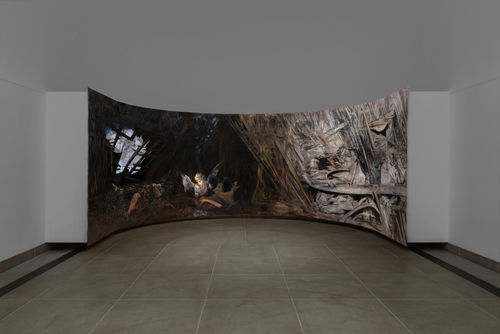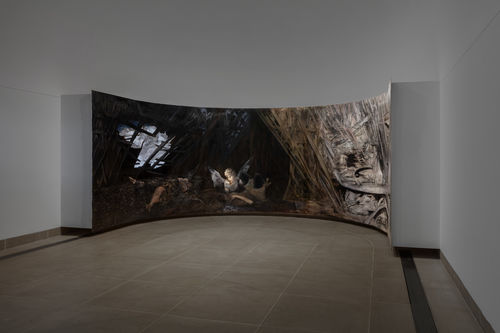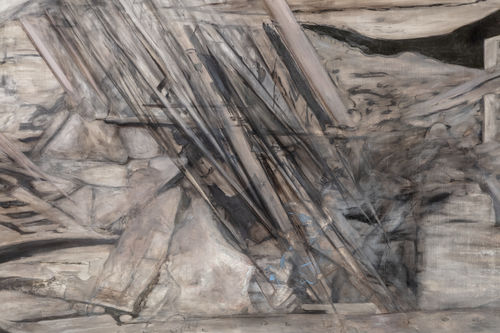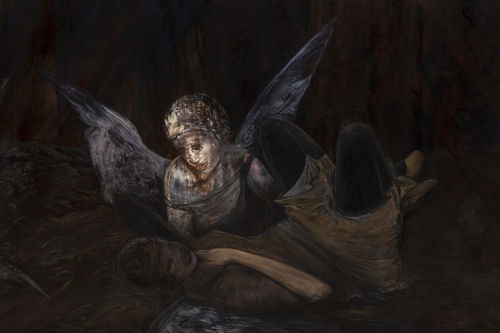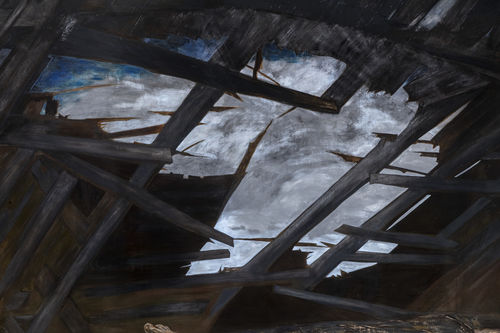
Hammer Projects: Janiva Ellis
- – This is a past exhibition
The first exhibition in Los Angeles by New York-based artist Janiva Ellis consists of a single large-scale painting, titled The Angels (2022), that responds to the unique architecture of the Hammer’s Vault Gallery. The museum’s architect, Edward Larrabee Barnes, designed the gallery for the presentation of the Codex Leicester, a manuscript of scientific writings by Leonardo da Vinci that was in the Hammer collection at the time of the museum’s opening in 1990. Barnes’s cathedral-like design lends a devotional atmosphere to the museum; Ellis’s curved painting mimics the shape of its central apse. A support structure offsets the painting from the existing walls, warping the proportions of the space and facilitating a more immediate encounter with the painted surface.
The angels situated on the left side of Ellis’s painting appear to merge with their dilapidated architectural setting. The brushstrokes that give shape to their individual forms seep into the background, leading the viewer’s focus away from the historical function of iconography and toward the artist’s painterly experimentation. While the lines and gestures that envelope the figures in The Angels are vivid and energetic, the work’s palette is solemn and muted.
The Angels is in dialogue with centuries of art history. Predating the Modernist preoccupation with the discourses of abstraction and figuration, the trope of the angel poses its own question to the problem of representation: To what extent can paintings engage with spiritual phenomena and that which cannot be seen? Ellis’s angels imply narrative possibility, but they are untethered to any specific reference. Decay and loss permeate The Angels, yet the intimate experience of looking closely and allowing oneself to succumb to the painting’s wrapping embrace reveals moments of flourish and signs of life amidst the debris.
Hammer Projects: Janiva Ellis is organized by Aram Moshayedi, Robert Soros Senior Curator, with Nicholas Barlow, curatorial assistant.
Biography
Janiva Ellis (b. 1987, Oakland) lives and works in New York City. Recent solo exhibitions include Rats, Institute of Contemporary Art, Miami (2021) and Tip Drill, 47 Canal, New York (2019). She has participated in group exhibitions, such as the Whitney Biennial, New York (2019), and the 2018 Triennial: Songs for Sabotage, New Museum, New York (2018), as well as a two-person exhibition with Donald Rodney at Arcadia Missa, London (2022). In 2018, Ellis was the recipient of the Rema Hort Mann Foundation Emerging Artist Grant and the Stanley Hollander Award.
Essay
By Aram Moshayedi
Janiva Ellis’s The Angels (2022) is a contemporary history painting at a scale reminiscent of the panorama—that nineteenth-century phenomenon that was a prequel to cinema and the recent technologies of virtual reality and augmented reality. These immersive visualities prioritize the viewer’s position in the experience. But Ellis’s painting, in contrast, reveals itself with great reluctance, unsettling its relationship with the world of the museum it occupies. It offers no ideal vantage point from which to stand and no perspectival marker that might carry us through the illusory window of representation. It refutes rather than affirms our centrality as viewers.
The Angels responds to the unique contours of the Hammer Museum’s Vault Gallery. The museum’s original architect, Edward Larrabee Barnes, designed the gallery to house the Codex Leicester, a manuscript of scientific writings by Leonardo da Vinci that was in the Hammer collection at the time of the museum’s opening in 1990. Ellis’s curved painting mimics the form of Barnes’s cathedral-like central apse, reinforcing a devotional atmosphere within the otherwise secular museum setting. A support structure offsets the work from the existing walls, warping the proportions of the space and facilitating a more immediate encounter with the painting’s surface.
The left side of the painting depicts something akin to a deteriorating attic. A cloudy sky, visible through a gaping puncture in the roof, casts light onto three winged bodies clustered amongst rotting, broken wooden planks and beams. The right half is composed of a field of diagonal lines and dramatic curves so volatile that it frustrates legibility. Tiny, ghostly silhouettes hidden in this field confuse the relationship between figure and ground. The two sides of the painting are visually unified by an implied triangle at the composition’s center, but the two halves also function independently, undermining a logical or systematic reading.
The mournful angels are not the conceptual center of what is being depicted; instead they act as anchor points, offering the familiarity that representational images promise. The energetic gestural lines that envelope them in detailed brushwork give shape to their forms but also cause them to blend into the background and merge with their dilapidated architectural setting. Their understated presence leaves the eye to wander over the artist’s varied applications of paint, including her additive and subtractive techniques and the different ways in which she renders depth through a flurry of diagonal lines. From the top left corner to the lower middle section, areas of paint have been sanded away to suggest raking beams of light.
The motif of the angel situates Ellis’s work in dialogue with centuries of art history and poses questions that predate the Modernist preoccupation with the dichotomy between figuration and abstraction: To what extent can paintings engage with spiritual phenomena, with that which cannot be seen? How does a painted image negotiate indeterminacy and immateriality despite its very material presence? The angelic quality of Ellis’s figures is untethered to any specific reference despite their art historical baggage.
Unlike Ellis’s earlier paintings, such as Bull Squall Bingo and Vacant Faith (both 2020), The Angels is not defined by expansive fields of bright color or motifs from animated films and television that provide context. Here, the palette is muted and somber. Certainly, the angel is a loaded signifier in the history of art, but the angels in this scene are embodiments of tragedy and despair, conditions of the prosaic world they inhabit. Surrounded as we are by disorder, disaster, and destruction, the widespread suffering is impossible to quantify. The Angels endeavors to convey the depth of grief and loss that are intimately tied to daily life, without the tragicomic relief that some of the artist’s previous works offered. Missing readily available references and source material, the painting provokes a response in viewers that can be frighteningly open-ended, if they allow.
The Angels assumes a responsibility for depicting that which cannot be expressed or portrayed through conventional means. The baseness of contemporary life seems almost palpable in the landscape it imagines. Despite the many crises that art and representation have faced in the last century, potent artworks and images such as this have stirred tangible responses in those who are willing and open recipients. More often than not, the discursive lenses that have historically emerged in response to developments in painting are wholly inadequate. Claims made on behalf of artistic trends—expressionism, realism, abstraction, figuration, and appropriation, for instance—have been lobbed at the expense of a viewer’s individual experience with a work of art. Ellis’s painting affords an opportunity to reevaluate how and why it remains productive to think about art at a moment of indifference toward the peril that surrounds us. The intimate experience of looking closely at The Angels and allowing oneself to succumb to its embrace reveals moments of flourish and visual affluence amidst the debris and ruin it portrays.



